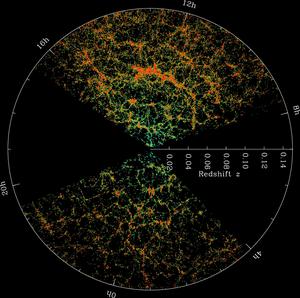Glossarbegriffe: Dunkle Materie
Description: Dunkle Materie soll eine Form von Materie sein, die keine Masse hat, nicht mit Licht wechselwirkt und selbst kein Licht aussendet. Die Dunkle Materie ist eine postulierte Form von Materie. Das heißt, dass sie bislang noch nicht beobachtet oder gefunden worden ist. Dunkle Materie könnte eine Erklärung für mehrere Phänomene in Zusammenhang mit Gravitationswechselwirkungen sein.
Erste Hinweise für die Existenz Dunkler Materie liefern Galaxien in Galaxienhaufen, die sich mit vergleichsweise hoher Geschwindigkeit bewegen. Eine zusätzliche Masse (in Form von Dunkler Materie) könnte erklären, warum diese Galaxien trotz ihrer Geschwindigkeit durch die Schwerkraft an ihren Haufen gebunden bleiben und nicht entkommen können.
Die von Vera Rubin und anderen Forscherinnen und Forschern durchgeführten Messungen der Geschwindigkeiten, mit denen sich Sterne und Gas in Scheibengalaxien bewegen, führten zu einer breiteren Akzeptanz des Konzepts der Dunklen Materie: Dort erfordern die Gesetze der Schwerkraft zusätzlich zur sichtbaren Materie eine beträchtliche zusätzliche Masse, um die beobachteten hohen Rotationsgeschwindigkeiten zu erklären: Ohne diese zusätzliche Masse sollten diese Galaxien "auseinanderfliegen".
In jüngerer Zeit haben Beobachtungen von Gravitationslinsen auf eine beträchtliche, nicht leuchtende Masse in Galaxienhaufen hingewiesen.
In der Kosmologie deutet die Expansionsgeschichte des Universums darauf hin, dass es mehr Materie im Universum gibt als nur die für uns sichtbare Materie. Die gängige Erklärung für das Wachstum der Strukturen im frühen Universum beruht ebenfalls auf dem Vorhandensein von Dunkler Materie. Aus diesen Gründen werden die kosmologischen Standardmodelle als "Lambda-CDM-Modelle" bezeichnet, wobei CDM (Englisch cold dark matter) für kalte, d.h. sich langsam bewegende, Dunkle Materie steht.
Die Natur der Dunklen Materie wird sowohl in der Kosmologie als auch in der Teilchenphysik intensiv erforscht und diskutiert. Die Hinweise für Dunkle Materie sind nach wie vor indirekt und beruhen auf Beobachtungen der Auswirkungen der Masse der Dunklen Materie auf leuchtende Materie oder Licht. Es gibt mehrere Vorschläge für noch nicht entdeckte Elementarteilchen, aus denen die Dunkle Materie bestehen könnte. Allerdings konnte bislang noch kein solcher Teilchenkandidat in Experimenten direkt nachgewiesen werden.
Es gibt auch alternative Erklärungsvorschläge, die behaupten, die entsprechenden Beobachtungen ohne die Beteiligung neuer Teilchenarten erklären zu können.
Zugehörige Glossarbegriffe:
See this term in other languages
Term and definition status: The original definition of this term in English have been approved by a research astronomer and a teacher The translation of this term and its definition is still awaiting approval
The OAE Multilingual Glossary is a project of the IAU Office of Astronomy for Education (OAE) in collaboration with the IAU Office of Astronomy Outreach (OAO). The terms and definitions were chosen, written and reviewed by a collective effort from the OAE, the OAE Centers and Nodes, the OAE National Astronomy Education Coordinators (NAECs) and other volunteers. You can find a full list of credits here. All glossary terms and their definitions are released under a Creative Commons CC BY-4.0 license and should be credited to "IAU OAE".
Zugehörige Medien
Dark matter
Bildnachweis: NASA, ESA, M.J. Jee and H. Ford (Johns Hopkins University) credit link
License: CC-BY-4.0 Creative Commons Namensnennung 4.0 International (CC BY 4.0) icons
SDSS Redshift Map
Bildnachweis: M. Blanton and Sloan Digital Sky Survey credit link
License: CC-BY-4.0 Creative Commons Namensnennung 4.0 International (CC BY 4.0) icons
Related Activities
Dark matter & dark energy (Part 2) – Understanding the nature of dark matter and dark energy
astroEDU educational activity (links to astroEDU website) Description: Let's investigate the nature of dark matter and energy with gravitational lensing!License: CC-BY-4.0 Creative Commons Namensnennung 4.0 International (CC BY 4.0) icons
Tags: Experiment , Invisible Age Ranges: 12-14 , 14-16 , 16-19 , 19+ Education Level: Informal , Middle School Areas of Learning: Guided-discovery learning , Interactive Lecture , Modelling , Problem-solving Costs: Medium Cost Duration: 45 mins Group Size: Group Skills: Constructing explanations , Developing and using models , Engaging in argument from evidenceDark matter and Dark energy (Part 1) – Discovering the main components of the Universe
astroEDU educational activity (links to astroEDU website) Description: Lets' investigate gravity, dark matter and dark energy with some very simple experiments!License: CC-BY-4.0 Creative Commons Namensnennung 4.0 International (CC BY 4.0) icons
Tags: Experiment , Galaxies Age Ranges: 12-14 , 14-16 , 16-19 , 19+ Education Level: Informal , Middle School Areas of Learning: Guided-discovery learning , Interactive Lecture , Modelling , Observation based , Other , Problem-solving Costs: Low Cost Duration: 45 mins Group Size: Group Skills: Constructing explanations , Developing and using models , Engaging in argument from evidence , Planning and carrying out investigations











